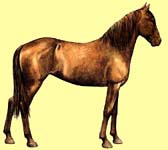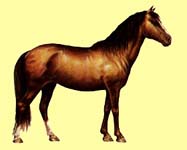|
|
Paso Fino and Peruvian Paso |
|
|
|
Paso Fino and Peruvian Paso |
|
 The Paso Fino, the mount of the Spanish Conquistadors, has proud ties to the glorious past and the prospect of an even greater future, as this elegant, smooth, gaited breed captured the hearts of horse lovers everywhere. The Paso Fino is the oldest true native of horse in the Western Hemisphere.
The Paso Fino, the mount of the Spanish Conquistadors, has proud ties to the glorious past and the prospect of an even greater future, as this elegant, smooth, gaited breed captured the hearts of horse lovers everywhere. The Paso Fino is the oldest true native of horse in the Western Hemisphere.
Columbus discovered a horseless America. Although the ancestors of the present day horse evolved in North America and spread to other parts of the world, horses vanished form the New World during the Ice Age, between 8,000 and 12,000 years ago.
Nearly 500 years ago, on his second voyage from Spain, Columbus brought a select group of mares and stallions from the Provinces of Andalusia and Cordela, and settled them at Santo Domingo. These horses were a mixture of Barb, Andalusian and Spanish Jennet. The Spanish Jennet not only possessed an extremely comfortable gait, but was able to pass the gait on to its offspring. The result of the blending of these horses was to become known as the Paso Fino breed - Los Caballos de Paso Fino (the horse with the fine gait). They became the foundation stock for remount stations of the Conquistadors. As Spanish settlers came to the New World, they brought more Spanish horses. During the nearly 500 years that Paso horses have been selectively bred and perfect and perfected in the Western Hemisphere, they have been called upon to perform a diverse role, first in the conquest of and then in the exploration and development of the Americas.
The Paso Fino is a tough, hardy little horse of about 14 hands, quiet and gentle by nature, and capable of the most arduous work across the mountains or in the sugar cane plantations. But the Paso Fino is at home on the trail and long distance riding, performing what is called 'a four beat single foot' - a singularly comfortable and untiring gait to which the rider can just 'sit down' and enjoy the ride.
For more information on Paso Finos, visit:

Peruvian Paso
The Peruvian Paso has similar ancestry to the Paso Fino, and was brought to Peru in 1532 by the Spanish adventurer Francisco Pizarro. Over the centuries they also retained the lateral gait associated with the ambling
Spanish Jennet. The Paso is thought to be 75%
Barb and 25%
Spanish or
Andalusian blood. The gaits have been developed and perfected to such a degree that they are regarded as a breed characteristic, distinguishing the Paso. These gaits allow the Paso to cover long distances over mountains and plains at remarkable speed, while affording great comfort to the rider.
Highly selective breeding of this small, very specialized horse over hundreds of years has produced a most distinctive animal of great endurance. The Paso is not a big horse, and does not have the characteristics of a galloper, but is a compact, muscular animal, broad and deep through the body and standing on short, strong limbs. The Paso stands between 14 and 15 hands high. The arched, muscular neck is fairly short and in proportion to the frame; it sits well into the withers and the broad, deep chest. The flat, broad face compliments the overall conformation of the Paso.
The eyes are very expressive and bright; the muzzle and jaw, fine, with a natural thickness through the throat. The Paso is intelligent, kindly and easily managed. The shoulders are strong and just sufficiently sloped to produce the required action in the forelegs; the Paso is able to canter, but rarely does, preferring its own natural gait. There is exceptional strength in the hind leg, which is carried well under the body while in motion. The limbs are of excellent soundness, with exceptionally strong pasterns, meeting the requirements of its gait. The hooves are strong and hard, while the horse is naturally agile and sure-footed.
The Gait. Essentially, the paso is a four-beat, lateral gait in which the forelegs are out to the side, while the hind legs take very long, straight strides, the quarters held low and the hocks well under the body. There are three carefully preserved divisions of the gait, which is quite unlike the lateral movements of other gaited breeds. It is the combination of the loose, flowing forelegs movement and the powerful drive of the hind legs that results in a ride of exceptional smoothness and can be maintained over long periods of time. The paso corto is the normal, easy, traveling gait; the paso fino, a slow, collected and elevated display gait; and the paso largo is an extended, fast gait. The Paso is reportedly capable of traveling at speeds up to 16 mph without rider discomfort.
Look for more information in our upcoming newsletters and on this site on the Peruvian Paso (revisited). We will examine the Peruvian Paso and the Paso Fino (also known as the Puerto Rican Paso) and the distinct differences between them. The results of this research will be made available soon.
If you'd like more information Online about the Peruvian Paso and how this unique breed differs from the Paso Fino, please visit:
Information collected from various sources including an article from "Southwestern Horseman."

|
© 1997-2007
NW Breyer Horse Club & Refiner of Gold Creations Equinealities in place since 1997, Section in place 2001, Updated 3/13/2007 |



|
| ||

|
|||||